The Horse Heaven Hills Wind Farm is a project planned by Scout Clean Energy of Boulder Colorado. The wind farm will be on 60,000 acres of farmland consisting of up to 244 wind turbines, each one from 500 foot to 671 feet tall. The turbines will be in up to 6 rows along 29 miles of our Western skyline.
___________________________________________________________________________________________________
Location of the Wind Farm and of the Wind Turbines
The wind farm will be along 29 miles of ridge line in the Horse Heaven Hills west of the Tri-Cities, from the Nine Canyon wind farms in Finley to Benton City to the north.
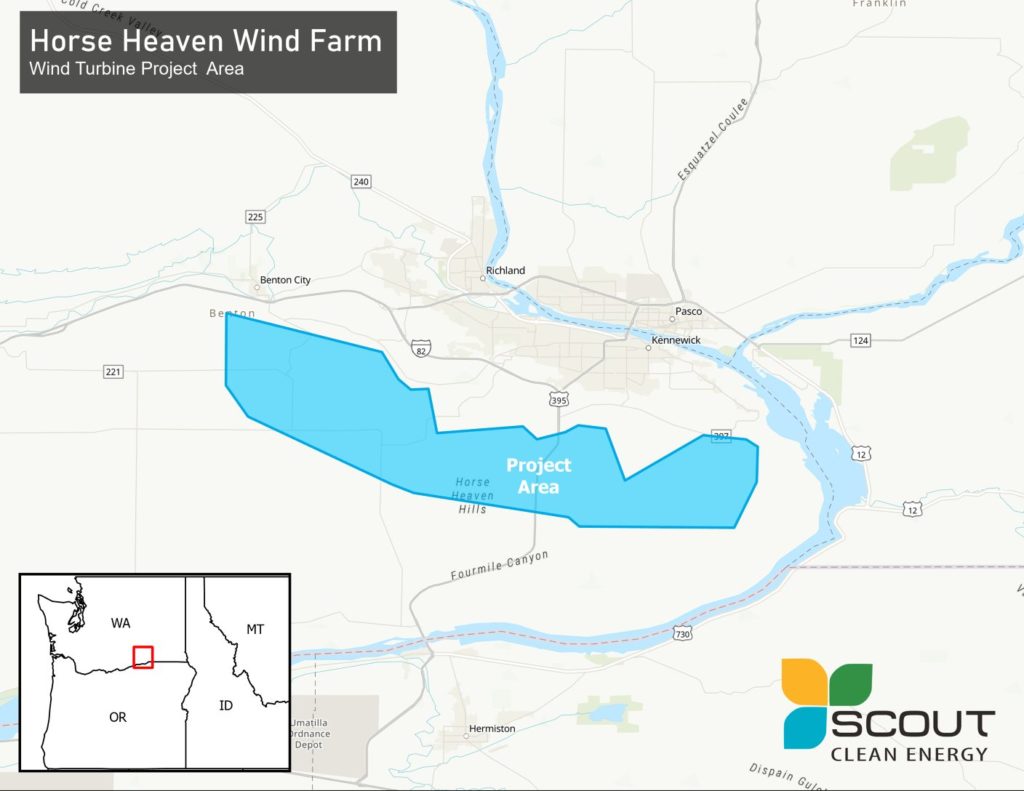
This map presented by Scout to EFSEC in their permit application shows the proposed locations of the wind turbines. It shows up to 6 rows of the 500 to 671 foot turbines on the ridges from Finley to Benton City. Wherever you live in the Tri-City and beyond, you will see the giant blades churning on the Western horizon.
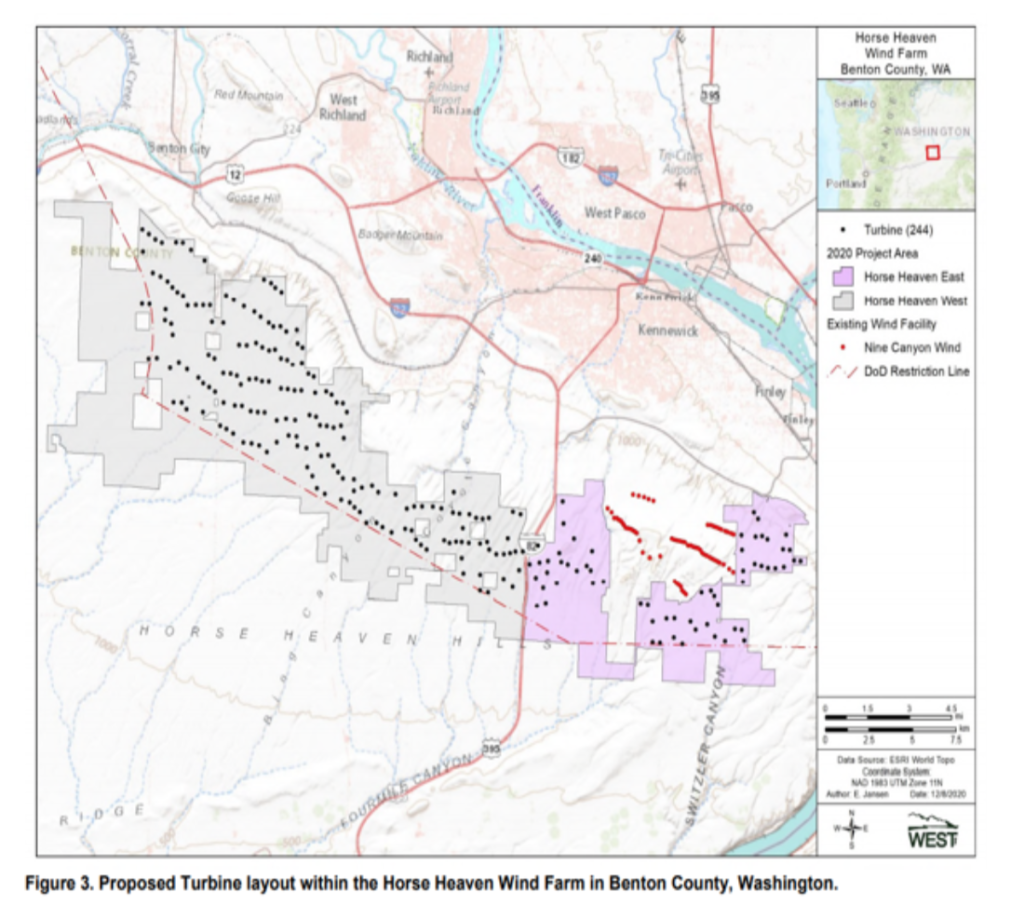
Size of the Project
At the Benton County hearing on Tuesday, March 16, 2021 the county stated that the Horse Heaven Hills Wind Farm will consist of a total of 72,000 leased acres. Of that land, about 6500 acres will be taken out of farm production. The 6500 acre number is high because of the solar part of this project that is taking up so many acres. It is believed that this solar facility will be one of the largest in the entire United States. Taking this many acres out of production alters the character of the farm based community.
The size of the HH windfarm project keeps increasing; the latest application with the State agency EFSEC show the possibility of three huge solar farms, transmission lines, battery storage facilities in addition to the wind farm. Here is an updated map of the planned industrial complex:
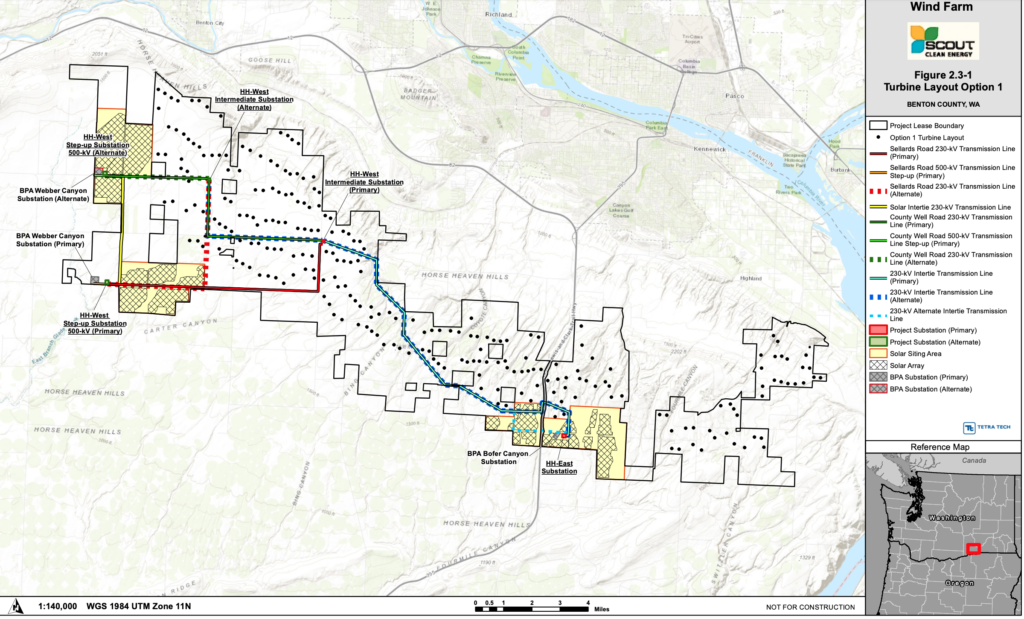
Visual Impact
This simulation was used by Scout in their application to show the visual impact of the planned wind farm. The simulated view of the two lower panoramas is looking southwest with new housing developments in Badger Canyon in the foreground. It shows up to six rows of 500 to 671 foot wind turbines lining the entire horizon; the hazy, cloudy sky is not typical of the Tri-City skyline with the impact on a typical summer day much worse.
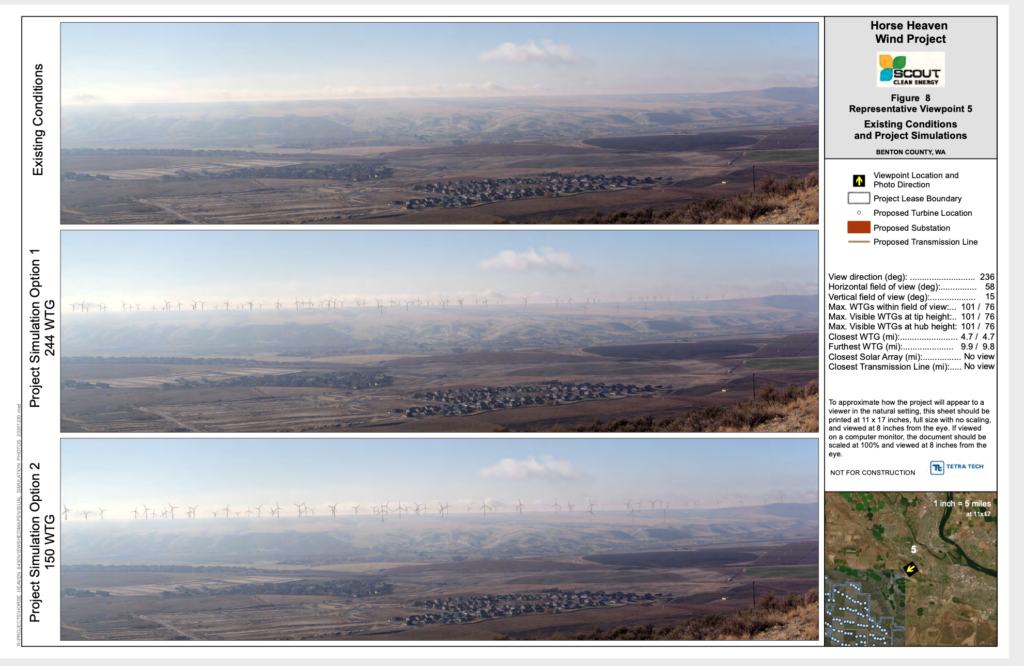
This enlarged view of the last image with the simulated wind turbines is taken from the top of Badger Mountain, our popular hiking destination; it gives a vivid impression of the changes that could happen to our skyline with this industrial project. Imagine the impact on real estate and winery tourism in our region!
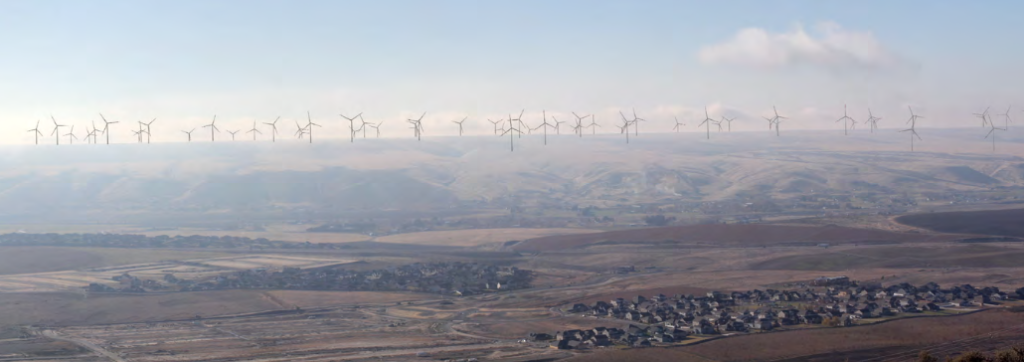
This map from the Scout application documents with EFSEC is called ViewShed map. The different shades of coloring indicate how many wind turbines will be visible at different locations; dark purple means there will be between 201-244 wind turbines visible, light purple is from 178 to 200 turbines, etc.
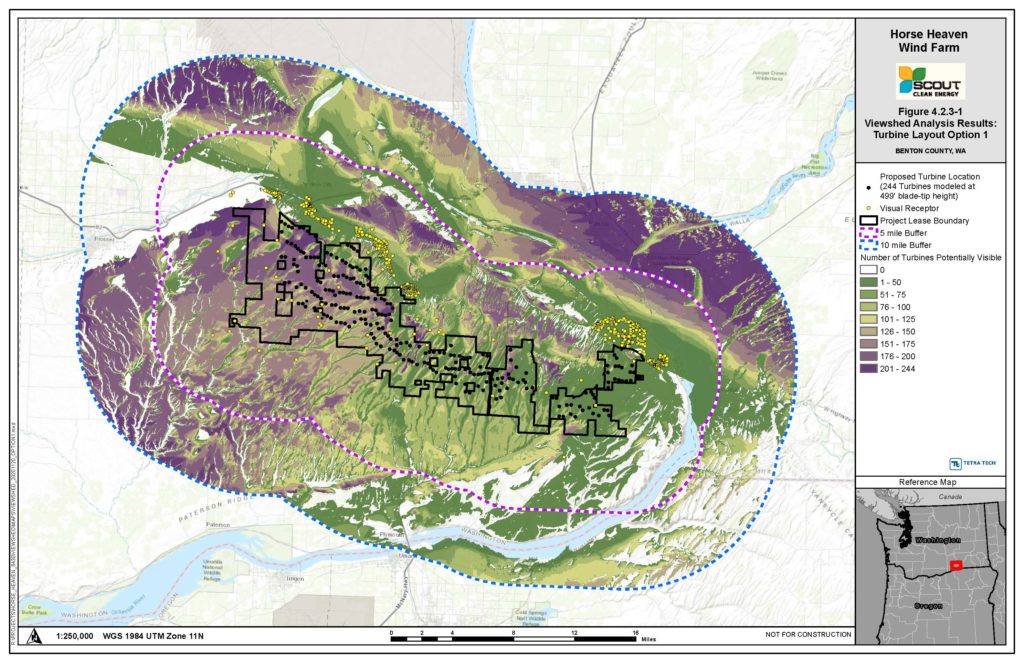
The map is hard to read so we made additions in red to show the towns and freeways, and we enlarged the area around the Tri-Cities. Now it becomes clear that people living on the west side of Badger Canyon/ West Kennewick/Rancha Reata, Thompson Hill, and Southridge will be looking at 200+ wind turbines of 500 to 671 feet. Similarly, folks in Kennewick along the 395 and in Pasco along freeway 182 will see over 200 wind towers. Not a pretty sight!
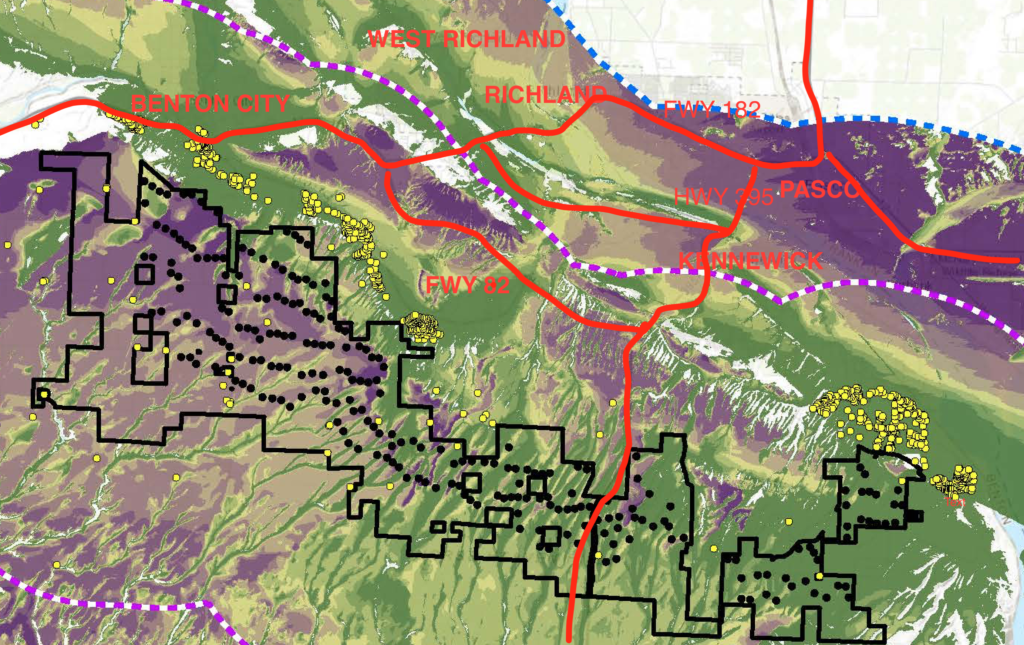
_____________________________________________________________________________________________________
Update 1/1/2023: Paul Krupin and Dave Sharp spent many hours numbering and indexing each wind turbine ; this way we can be specific in our comments to EFSEC about which ones affect us the most.
Use this link to download a .pdf file:
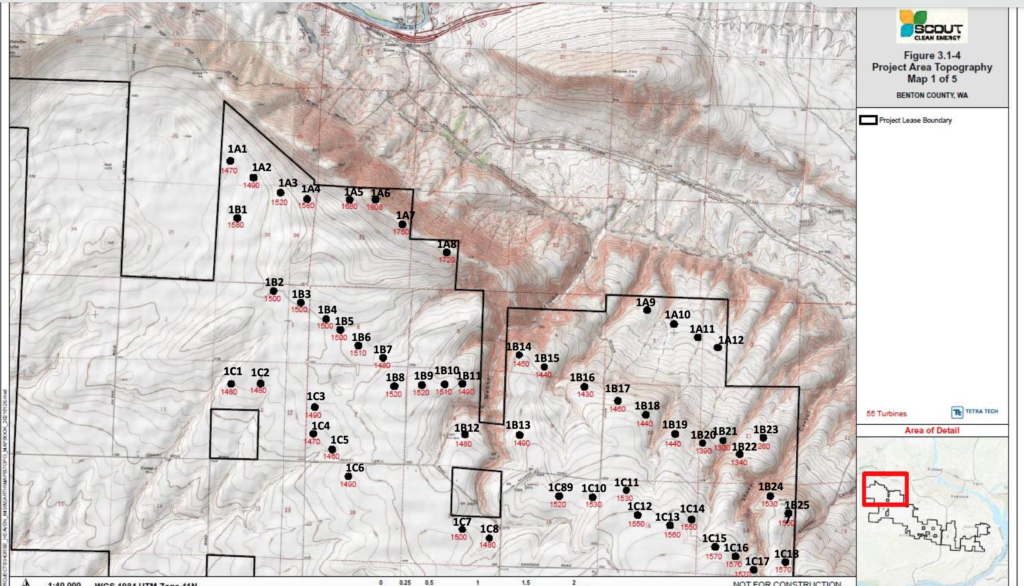
They also copied the map on top of the wildlife habitat map; get the map at this link:
https://presari.com/files/media/42/deishabitatmapswithturbinenumbers.pdf
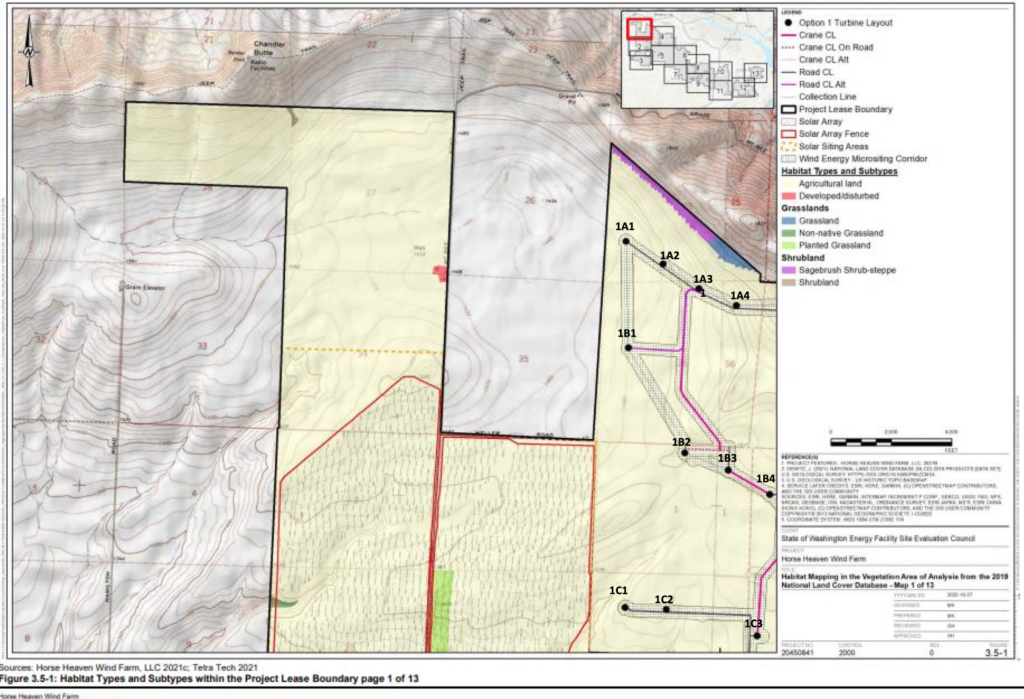
Paul Krupin has made maps for different residential locations showing the numbers and distances to the turbines. Let him know if you would like such a map for your neighborhood so you can comment to EFSEC with specific details how the noise, flicker and visual pollution will affect you.
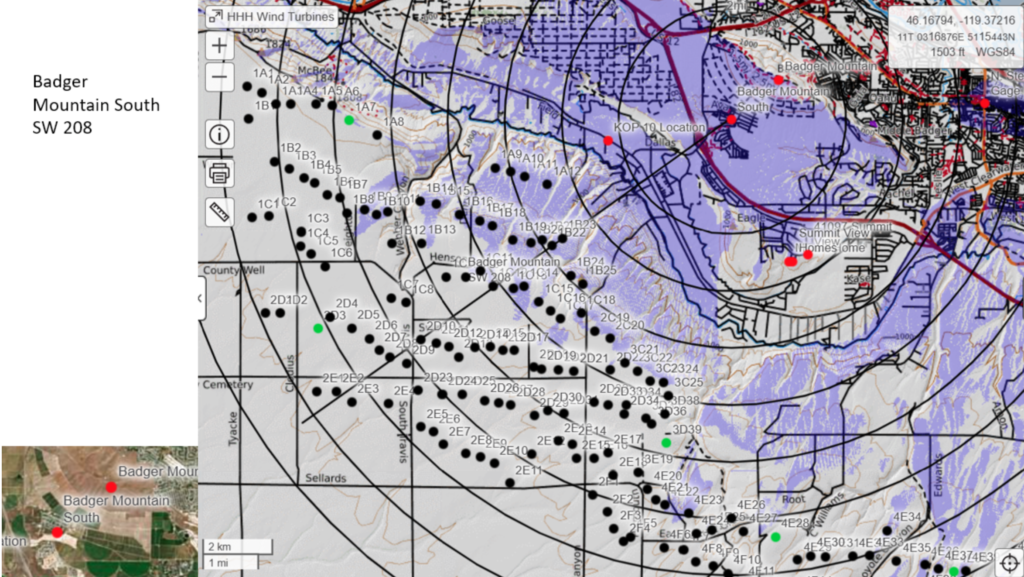
_____________________________________________________________________________________________________
A Tour Guide of the Heaven Hills Energy Project
Project Maps, Topo Maps, Land Ownership, and GIS Aerial Photos
Created by Paul J. Krupin and Dave Sharp
Planning Your Road Tour
The Horse Heaven Hills Wind & Solar Energy Project extends about 25 miles from east to west and is up to 8 miles wide north to south. It encompasses nearly 115 square miles. It takes at least four hours to simply drive the project on a tour to even do a cursory look at the lands that are affected by the proposals. Even then, only a limited amount of time is available for stops at the various key project locations to observe and grasp the significance of the locations and impacts of the project components. It takes several days to visit and survey the lands and resources in more detail with more time at the numerous locations.
Four towns (Benton City, Richland, Kennewick, and Finley) and numerous surrounding sub-divided communities with tens of thousands of people in residences are located and are immediately adjacent to and within 1 to 5 miles of the proposed project boundary. West Richland, West Pasco, Pasco, and Burbank will also be able to see the turbines and lights at night. Indeed, the number of homes, businesses, and people who live and work in the Tri-Cities who will be able to see the proposed wind turbines is significant. As of July 1, 2021, the U.S. Census Bureau estimates the population of the metropolitan area to be 308,293, making it the third-largest metropolitan area located entirely in Washington, after the Seattle metropolitan area and the Spokane metropolitan area. The red lights from the wind turbines will be visible from all the towns in the Tri-Cities at night.
The tour guide with pictures can be downloaded from:
https://presari.com/s/X30075000148800
Drone photos taken 500 feet above the ground at proposed turbine locations off Dennis Road and Weber Canyon. Provides perspective and insight into the question “who will be able to see the wind turbines”.
Drone Photo Credit to Bruce Bjornstad, Richland Washington.

This map shows the proximity of the wind turbines to subdivisions in Badger Canyon along Weber Canyon.

This Viewshed map from Scout shows where in the Tri-Cities the 244 turbines will be visible; for example, dark purple means that all 244 turbines will be visible. The pink captions added by Paul Krupin and Dave Sharp show the number of residents living in these locations. For the 300,000 residents of the Tri-Cities, there will be no escaping the industrial complex on their horizon.

___________________________________________________________________________________________________
Horse Heaven Hills American Viticulture Area
The planned wind and solar facility is located in the Horse Heaven Hills American Viticultural Area (AVA). This area has the single largest wine making facility in Washington State, the Columbia Crest Winery owned by Chateau Ste. Michelle. Washington is seeing a growing economic benefit from the grapes grown in the extremely special soil and environment of the Horse Heaven Hills AVA. How special is the soil? Wikipedia: “The sandy loam vineyard soils create a nearly inhospitable environment for the phylloxera louse, which may be one of the reasons why the phylloxera epidemic has not ravaged the Washington wine industry as it has the Californian and French wine industries in the past.”
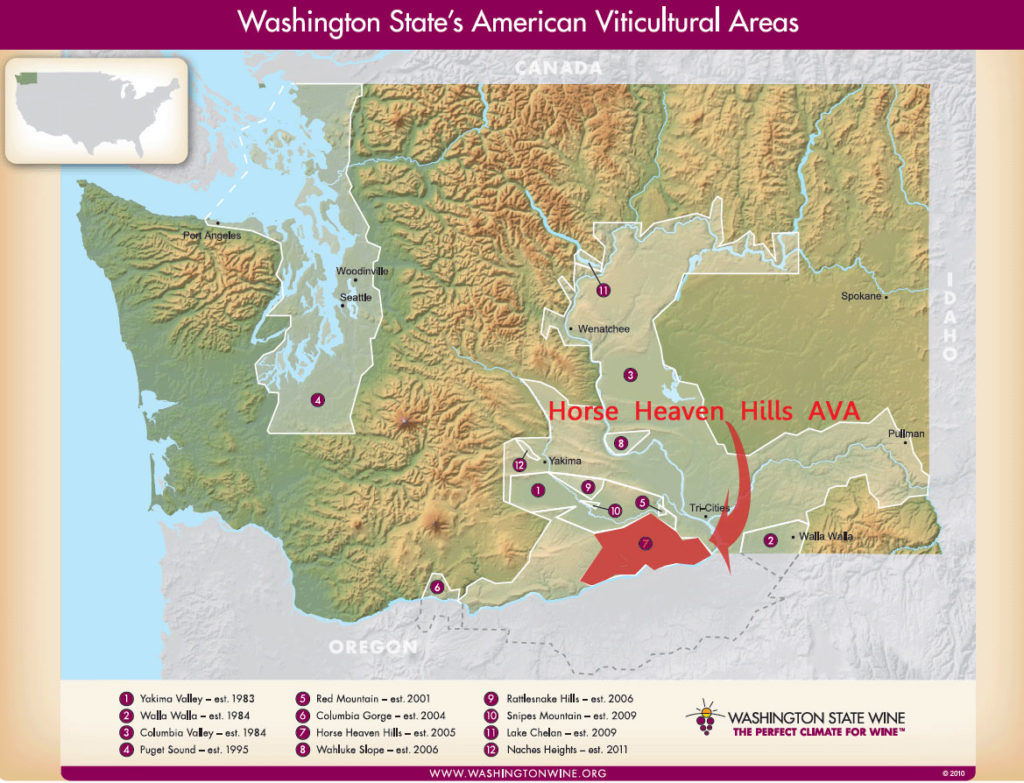
___________________________________________________________________________________________________
This original article about the Horse Heaven Hills Project by Annette Cary appeared in Tri-City Herald on February 4, 2020; the project has since increased in scope and size.
Wind farm would have up to 212 turbines 500-foot turbines proposed for site south of Tri-Cities
A wind farm along 24 miles of the ridgeline of the Horse Heaven Hills is proposed south of the Tri-Cities. Scout Clean Energy, based in Boulder, Colo., could start construction on the Horse Heaven Wind Farm as early as October, said project manager David Kobus, who also worked on the Nine Canyon Wind Project. The new project is planned to include as many as 212 turbines in rows from near Jump Off Joe Butte to the southwest, with much of it south of Badger Road. It would wrap around the already operating Nine Canyon Wind Project. About 6,000 acres of land will be leased from dry land wheat farmers, including farms growing wheat and those with land in conservation reserves, Kobus said. In addition, about 1,600 acres would be on Washington State Department of Natural Resources land. Scout would use turbines comparable to the largest on Energy Northwest’s 75-acre Nine Canyon project. The turbines would stand below the 500-foot height with a blade fully extended, which is the limit to meet air space restrictions. The new project could generate about 600 megawatts of electricity. In comparison, Nine Canyon has a maximum output of about 96 megawatts of electricity. Energy Northwest’s commercial nuclear power plant near Richland, the Columbia Generating Station, can generate 1,207 megawatts, which is enough to power a city the size of Seattle, plus some of its metro area. The Horse Heaven Wind Farm was initially proposed as a 250-megawatt project, but has been expanded. Scout Clean Energy expects to submit a conditional use permit application needed to use the land for a wind farm to Benton County in a matter of weeks, Kobus said. It would include an environmental checklist. Kobus expects the county application to be completed as soon as early March. Then a public hearing would be held, followed by a second public hearing at which the county hearings examiner would present conclusions on the application. If the process proceeds as Scout Clean Energy hopes, a county permit could be issued in July. The company then would need to find buyers for the electricity that would be produced. It could have buyers in place in time to start construction of wind turbines in October. The company also will be working with the Kennewick Irrigation District to get an easement to the Bonneville Power Administration’s Red Mountain substation. It also plans to coordinate with the Benton Public Utility District to work out an agreement to co-locate a transmission line with an existing PUD line. A second substation would be built at Bofer Canyon and Beck roads south of the Tri-Cities by Highway 395. The wind farm would be visible from Highway 395 south of the Tri-Cities to the northwest of the Nine Canyon wind farms. At Benton City the tops of turbines could be visible, but partially hidden by Bureau of Land Management land to the south and southeast of the town. Scout Clean Energy has wind farms operating in Oklahoma, Texas and California, with projects under construction in Indiana and Texas.
___________________________________________________________________________________________________
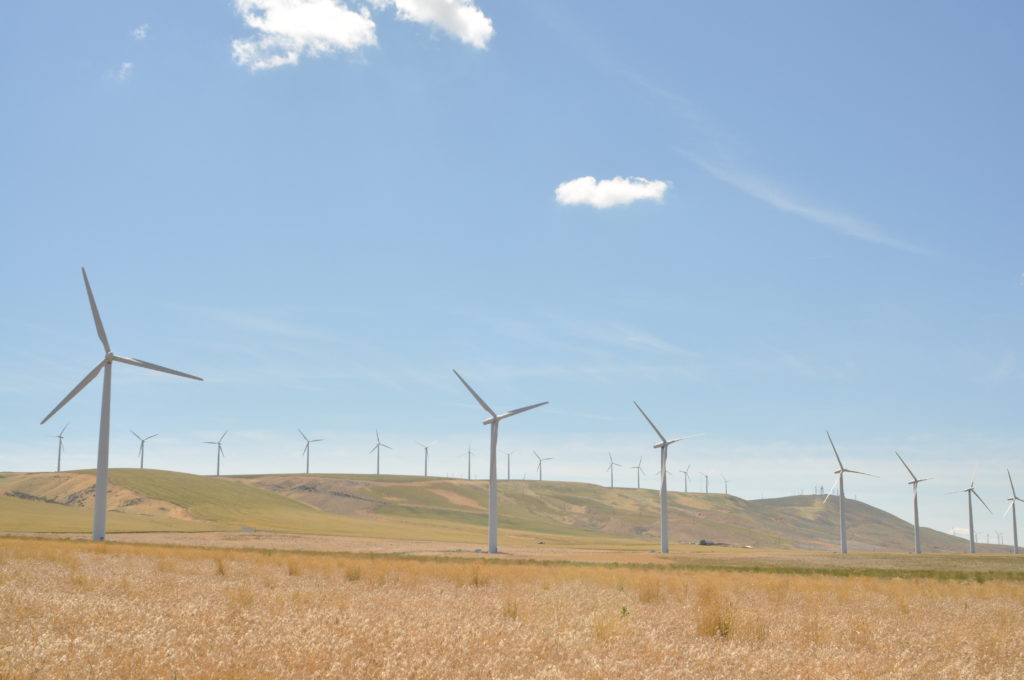
This updated article in the Tri-City Herald from Sep 2, 2020 details the expanded plans by Scout Clean Energy to add more turbines and also to add battery storage
by ANNETTE CARY
235-turbine wind farm planned south of Tri-Cities wants to add something more
Scout Clean Energy is expanding its proposal for a wind farm south of Kennewick to add solar and battery storage. The revised proposal for the Horse Heaven Wind Farm would increase the total generation possible from 600 megawatts of electricity to 850 megawatts. Some of the increased generation could come from expanding the possible maximum number of turbines from 212 to as many as 235. The expansion of the proposed project along 24 miles of the ridgeline of the Horse Heaven Hills is possible because Scout was able to obtain more capacity on the Bonneville Power Administration electrical grid.
The addition of wind and solar was driven in part by the dropping costs of solar and battery storage and also by what Scout has heard from Tri-Cities area residents over the last six months. “Throughout the development process, our team has been diligently examining ways to structure the most efficient project that will maximize the local resources and also integrate the power into the local grid reliably,” said Dave Kobus, Scout’s lead project manager for the Horse Heaven Wind Farm. Combining wind, solar and battery storage helps deal with one of the biggest challenges with renewable power — the varying levels of electricity available to the grid depending on whether the wind is blowing or the sun is shining. Building wind, solar and battery storage at the same location can improve grid reliability by providing electricity over more hours and storing power for when consumer demand for it is highest.
As Scout has been explaining is proposed project in the Tri-Cities area over the last six months, it found many residents with advanced knowledge of power systems and grid requirements, Kobus said.
About 40% of Washington state’s power is produced within a 100-mile radius of the Tri-Cities. What’s more, 90% of the total wind generation in Washington and Oregon is within a 125-mile radius of the Tri-Cities, according to the latest figures available from the Tri-City Development Council.
“We have heard concerns about how renewable power such as wind affects the local grid,” he said. Plans for the expanded project should alleviate some of the local apprehension, he said. The percentage of the project devoted to wind, solar and battery storage could change depending on the preferences of the purchaser of the power from the project.
The project plans to seek permits to start production in two phases. It could begin producing up to 350 megawatts of electricity in 2022 and two years later add up to 500 megawatts of electricity production.
One of Scout’s next steps will be to file a conditional use permit application with Benton County, which will include an environmental review, in the next few months. Two public hearings are required.
Proposed Wind Farm
Scout Clean Energy plans a 60,000-acre wind farm on Benton County farm land south of the Tri-Cities along the Horse Heaven Hills ridgeline south of Badger Road. The project is being expanded to include solar and battery storage. This view from the Reata Road overpass across Interstate 82 faces southwest towards Benton City. Bob Brawdy Tri-City Herald
The filing has been delayed by several months by the coronavirus pandemic. Scout has been working on the project since late 2016, including leasing land and conducting environmental studies. Construction could start as soon as late 2021.
Number of jobs
The wind farm would be visible from Highway 395 south of the Tri-Cities to the northwest of the already operating Nine Canyon Wind Project, which the new project would wrap around. Turbines would be placed in rows from near Jump Off Joe Butte to the southwest, with much of the project built south of Badger Road. It would be about four miles south of the Tri-Cities at its closest point.
About 60,000 acres of land will be used, much of it leased from dryland wheat farmers, including farms in production as well as acreage in conservation reserves. About 1,600 acres would be Washington state Department of Natural Resources land.
The proposed project would be much larger than Nine Canyon Wind Project, which has a maximum output of about 96 megawatts of electricity.
By comparison, the Columbia Generating Station nuclear power plant near Richland can generate 1,207 megawatts, which is enough to power a city the size of Seattle, plus some of its metro area.
Scout is touting the economic benefits of the project, saying that it could create at least 300 temporary construction jobs and 16-20 permanent jobs during operation. It also would create millions of dollars in property tax revenue that would reduce the tax burden on other property owners, according to Scout
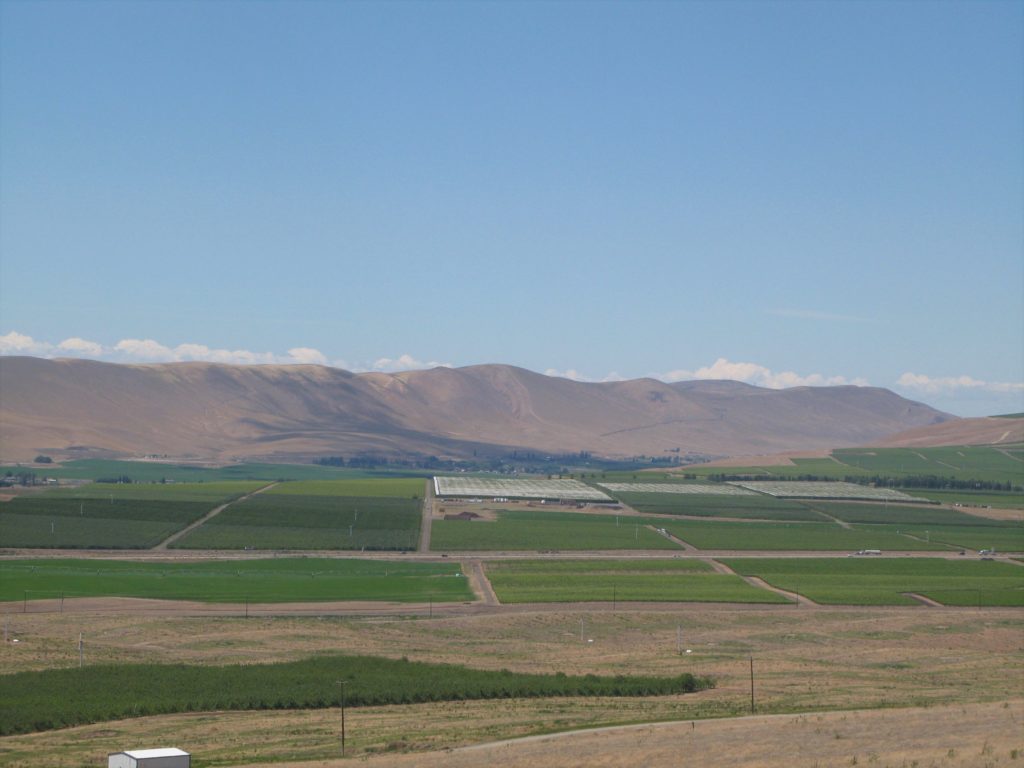
___________________________________________________________________________________________________
This article about the Benton PUD position paper on wind farms (see Benton PUD Position Paper) and the Horse Heaven Hills Project appeared in Tri-City-Herald on November 8, 2020
Will wind farms raise power prices and increase blackouts? Benton PUD thinks so
Adding more wind turbines in the Northwest is a bad idea, says the biggest public utility district in the Tri-Cities region. The drawbacks of adding more wind farms outweigh the possible small environmental benefit and could raise electric prices locally, says the Benton Public Utility District. The Benton PUD, with 54,000 customers in the Tri-Cities area, issued a formal declaration that it does not support further development of wind power in the Pacific Northwest. It is concerned that increases in Northwest retail electricity rates could harm the economy by eroding the “economic development advantage low rates has given our region.” Although the PUD does not call out any specific projects in the policy paper, its wind farm opposition comes as Scout Clean Energy of Colorado is preparing to apply for a permit from Washington state for the new Horse Heaven Wind Farm in Benton County.
The project along 24 miles of the ridgeline of the Horse Heaven Hills south of Kennewick to near Benton City would include up to 235 wind turbines, plus solar panels and battery storage.
Scout Clean Energy believes Benton PUD policy paper is “out of step with current technology” and “inconsistent with state policy, most importantly the Clean Energy Technology Act,” said Javon Smith, who is in charge of community relations for the new wind farm.
Renewable Northwest, a renewable energy advocacy organization based in Portland, agrees. “The paper relies on false and outdated claims over current scientific data and economics,” Nicole Hughes, executive director of Renewable Northwest, said in a statement.
Benton PUD concerns about potential new wind farms include quality of life in Benton County, the cost of electricity and the need to develop power projects that can operate consistently no matter the weather to reduce the risk of power grid blackouts as coal plants are shut down under the Clean Energy Technology Act.
NORTHWEST WINDPOWER
“Existing wind farm development in Washington state and along the norther Oregon border has already resulted in the industrialization of previously scenic hillsides, canyons and desert vistas in the region in and around Benton County,” said the 15-page PUD policy paper.
Scout Clean Energy plans a 60,000-acre wind farm on Benton County farm land south of the Tri-Cities along the Horse Heaven Hills ridgeline south of Badger Road. It has announced plans to expand the project to include solar and battery storage. Bob Brawdy TRI-CITY HERALD
“Before PUD customers and citizens throughout our region accept further sacrifice of the natural beauty and open spaces that are part of our way of life, we want them to know there are other options we should be asking our legislators and utility industry leaders to urgently and seriously consider,” the PUD paper said.
Reasonable questions have been raised about the ability of wind power to cost-effectively contribute to the nation’s power needs and the full environmental and ecological impacts of wind power compared to other energy technologies, the paper said.
Wind power in the Pacific Northwest will not result in consequential reductions in national or global greenhouse gas emissions for Washington state utilities, the paper said. Because of hydroelectric generation, Washington state has a reliable energy source that has historically contributed no more than 0.5% to the national’s annual total greenhouse gas emissions from electricity production.
ELECTRICITY BLACKOUT RISK
The Benton PUD is concerned that the continued push for more wind projects by developers and many elected officials will do nothing to alleviate the looming risk of power grid blackouts in the Pacific Northwest.
Washington state’s 2019 Clean Energy Transformation Act sets a deadline in five years for eliminating coal-fired energy. But the politically preferred technologies, including wind and solar power along with batteries, are not ready to provide solutions at the scale needed to prevent possible blackouts as soon as next year, the PUD paper said. The Northwest Power and Conservation council estimated that accelerated coal-plant retirements could increase the risk of blackouts to a 26% probability by 2026 if utilities are unable to replace the generating capacity of shuttered coal plants. The best environmentally responsible strategy to meet the Clean Energy Transformation Act’s end goal of 100% clean electricity in Washington state by 2045 is to transition from coal power to natural gas and then natural gas to nuclear, the PUD paper said. All provide consistent power that is not dependent on the weather. With existing hydro and nuclear power in the Pacific Northwest, meeting the 100% clean electricity goal in the region through additional wind and solar would require a land area 20 to 100 times the area of Seattle and Portland combined, the PUD paper said. Wind power requires 30 to 45 as much land and 10 times as much concrete and steel to produce the equivalent power of nuclear, the paper said.
HYDRO, NUCLEAR POWER
Now Benton PUD, which relies mostly on hydro and nuclear for power, must purchase additional power during hot summer months and some of the worst winter cold snaps.
But those are typically times when the wind does not blow, which will not help Benton PUD when it is trying to purchase more power. Energy production from wind farms in the region is often high at the same times that hydro generation peaks, limiting the value of surplus hydro sales. Benton PUD is among the utilities that can sell their percentage of power purchased from the Bonneville Power Administration when they do not need all of it to help offset what they charge local customers. “Building more wind farms in the PNW will contribute to untimely energy supply gluts and low short-term market prices, which reduces surplus hydro energy sales revenues, increases net hydro power costs and puts upward pressure on retail rates Benton PUD and other utilities charge our customers,” it said. “This ‘double paying’ is why electricity rates in countries and states with high wind penetrations are rising despite the declining costs of this popular renewable energy source,” the PUD paper said. “Benton PUD believes further wind power development will unnecessarily contribute to increases in Northwest utility retail electricity rates, which could erode the economic development advantage low rates has given our region.” As more large wind farms contribute to surplus annual energy supplies at times in the region, the opportunities erode for new types of nuclear, such as small modular reactors, to become economically viable, it said.
CRITICISM OF WIND FARM POLICY PAPER
“Benton PUD’s position appears to be based on little more than a personal preference not to see wind turbines,” said Hughes in her statement for Renewable Northwest. The Benton PUD policy paper represents the perspective of just one of Washington state’s 28 public utility district, and it appears to be an outlier, said Smith of Scout Clean Energy. “There is not data out there to support a claim that the addition of wind in our portfolio in the Northwest will result in an increase in electricity rates,” she said. The Northwest Power and Conservation Council predicts that wind and solar costs will continue to drop, she said. But advance nuclear options will be considerably more costly than electricity from wind farms, she said.
Scout Clean Energy is relying on the analysis of Randy Hardy, head of the Bonneville Power Administration in the 1990s, to discount the Benton PUD’s concerns that wind production would add to the regional hydro surplus and depress prices for sales during the spring runoff. The Horse Heaven Wind Farm’s production would be dwarfed by hydro generation, according to Hardy. But more importantly, the generation of the proposed Benton County wind farm during the winter will be especially valuable as Pacific Northwest coal plants retire through 2030, creating a need for more electricity.
Scout Clean Energy plans a 60,000-acre wind farm on Benton County farm land south of the Tri-Cities along the Horse Heaven Hills ridgeline south of Badger Road. The project is being expanded to include solar and battery storage. This view from the Reata Road overpass across Interstate 82 faces southwest towards Benton City. Bob Brawdy TRI-CITY HERALD
OPPOSITION TO WIND FARM
Two Tri-Cities residents who share some of the PUD’s concerns have started the website save-our-ridges.org to raise awareness of the risk to the Columbia Basin’s panoramic views. “The hills and ridges rising behind the Tri-Cities are visible from far in the Columbia Basin. They need to be protected from massive development as they are the signature of our region,” says the website developed by Rich Gerlitz of Richland and Markus Stauffer of Pasco. Stauffer is a retired geochemist and Gerlitz is retired from the financial industry. “A Hike on Badger Mountain Will Never Be the Same” says one post on the website, showing a view of a ridgeline topped with wind turbines to illustrate the possible view from the top of Badger Mountain. More will be known about exactly where in the Horse Heaven Hills the proposed turbines could be sited once Scout Clean Energy submits a site certification application to the Washington state Energy Facility Site Evaluation Council.
Gerlitz has fond memories of driving a combine for 12 hour overnight shifts in the Horse Heaven Hills as a young man. He remembers gazing at the night sky and full moon, not the blinking red lights of wind farms, he said.Such a project would not be allowed if it was marring the view of Seattle residents, such as in Elliott Bay, he said.
Stauffer said he is concerned that the massive turbines proposed for wind farms last only 15 to 25 years, and are difficult to recycle. If new, more efficient or less costly technology were to make wind turbines obsolete, driving wind farm and companies into bankruptcy, its unclear who would be responsible for the defunct wind turbines that create visual pollution, he said.
But Smith counters the opposition from Stauffer and Gerlitz saying that Scout Clean Energy can only build projects in places where numerous landowners want to participate. “We currently have substantial acreage under wind energy lease and easement agreements, and because these are voluntary, we simply would be not at this point without the support of many local residents,” she said. The project has the potential to stimulate the local economy by creating hundreds of construction jobs, full-time operational jobs, as well as millions of dollars in property tax revenue for the host community, according to Scout Clean Energy.
WASHINGTON STATE APPLICATION
Scout Clean Energy had initially announced plans to seek a permit from Benton County, but announced on Friday it would use the alternate method of applying through the Washington State Energy Facility Site Evaluation Council (EFSEC), the state board charged with the siting of major energy facilities. It expects to file an application with the state in the coming months. “In recent months the project size and scope have expanded, adding to the environmental review complexity,” said Dave Kobus, Scout’s lead project manager for the Horse Heaven Wind Farm. Initial plans did not include solar energy and battery energy storage. “EFSEC provides a ‘one-stop’ siting process for major energy facilities and will ensure robust public involvement opportunities that match or exceed the local permitting process,” he said. The EFSEC board includes a representative from the state’s Departments of Ecology, Commerce, Fish and Wildlife, and Natural Resources, plus the Utilities and Transportation Commission. Because the proposed wind farm is in Benton County, the county is expected to be allowed to add a voting member to the siting council. Benton County also will review the application for consistency with local land use and zoning laws. At the end of the EFSEC review — which includes public meetings, independent experts, environmental studies and formal hearings — EFSEC will forward a recommendation to Gov. Jay Inslee for a final decision.
___________________________________________________________________________________________________
This article about the Horse Heaven Hills Project appeared in The Tri-City Area Journal of Business in May, 2020
Colorado firm plans 600-megawatt Horse Heaven Wind Farm
TCAJOB Staff|May 2020
A 600-megawatt wind farm south of Kennewick will employ 300 during construction and help cement the region’s status as Washington’s center for wind energy.
Scout Clean Energy of Boulder, Colorado, will apply for a conditional use permit from Benton County for its Horse Heaven Wind Farm project later this year. Pat Landess, spokesman for Scout, said the project is on schedule although it has had to change its public outreach strategy because of the coronavirus pandemic and Washington’s continuing stay-home orders. It is communicating updates via a Facebook page.
The wind farm will be developed in phases on 60,000 acres in the Jump Off Joe area south of the Tri-Cities. Demand will drive the construction schedule. Work begins in 2021, with commercial operations beginning in 2022. “The ridges here have abundant wind resources that make the location ideal for a wind energy development,” Landess said.
There are more than 3,000 megawatts of wind energy in Washington, or 1,725 turbines that represent 7.3 percent of all in-state power production, according to the American Wind Energy Association. The Mid-Columbia has long been a critical player in renewable wind energy in Washington. The Stateline Wind Project, which debuted in 2001, straddles the Washington-Oregon border at Wallula Junction. It was one of the first and largest wind installations in the region.
The company will install up to 212 General Electric wind turbines, each costing about $4 million, or $850 million in 2020 dollars at full build-out. Construction will require 300 workers. The project will employ 12 to 14 at full operations. Mid-Columbia businesses are encouraged to contact Scout Energy about doing business with the project. The contractor will buy local materials and services, Landess said. The wind farm will produce power to support up to 140,000 homes. More importantly, it will help Washington pursue a 2019 goal of carbon-neutral power by 2040. The company is marketing the project’s power output but has not identified customers.
Horse Heaven Wind Farm is subject to review under the Washington State Environmental Policy Act and consultation with the Washington Department of Fish and Wildlife and the U.S. Fish and Wildlife Service. The review includes impacts on the environment, humans and wildlife, as well as the cultural and aesthetic effects.
Most of the project will occupy cultivated farmland. Each turbine takes about half an acre out of production. The turbines are linked by an underground electric “collection” system as well as communications lines, two substations with operations and maintenance shops. It expects to send power via the Bonneville Power Administration system through an interconnection agreement. The project will generate an estimated $27 million in taxes over the its expected 25-year lifespan. The company said that it has commitments to landowners to remove and salvage wind turbines and restore the site to pre-project status at the end of the project lifespan. Horse Heaven Wind Farm combines two prior projects that date to 2016. Scout Clean Energy bought the assets of Wpd, a wind energy producer. Tri-Citian Dave Kobus is the lead project manager.
___________________________________________________________________________________________________
Who is Scout Clean Energy:
It is a Limited Liability company registered in Delaware. Their corporate office is in Boulder, Colorado.
Michael Rucker, CEO of Scout Clean Energy
Javon Smith, 509-490-4892, Javon@scoutcleanenergy.com ; she is the communications person for the HHH project.
David Kobus, Scout Project Manager for the Horse Heaven Hills wind farm project
Scout uses subcontractors to do a lot of the permitting, planning, and execution of their wind farm projects. TetraTech did several studies for Scout that were used in the permit request with EFSEC; they are also involved in a law suit in California with two supervisors convicted to 8 months in prison for falsifying data for a clean-up project for the Navy.
Jobs and Tax Revenue
Scout is trying very hard to claim that this giant project will bring great benefits to our local economy. In May of 2020, they were saying that it could create at least 300 temporary construction jobs and 16-20 permanent jobs during operation for the $850 million project. It also would create millions of dollars in property tax revenue that would reduce the tax burden on other property owners. This is in addition to all the electricity delivered to our local grid. A year later, they don’t claim they will provide power to the local grid (we don’t need it) but the other “benefits” have increased greatly; in an advertisement in the Tri-City Herald on March 7, 2021, Scout now claims:
$ 19.4 million in the first year of operation for local taxes, and $ 262.9 million over 35-year operating life!
These claims are very suspicious: First of all, the life span of a wind turbine is more like 15 to 25 years than the 35 years claimed by Scout. Second, estimating the tax to an accuracy of 262.9 million (that is to the nearest 900’000 dollars) over 35 years is plain wishful thinking. What do we know about the financial or the energy markets in the year 2056? Does this tax benefit to our community included the hundreds of millions of dollars needed to clean up this Scout wind farm at the end of its life span? Yes, these financial benefits were “calculated” by TetraTech, according to Dave Kobus at the EFSEC hearing (see above about TetraTech).
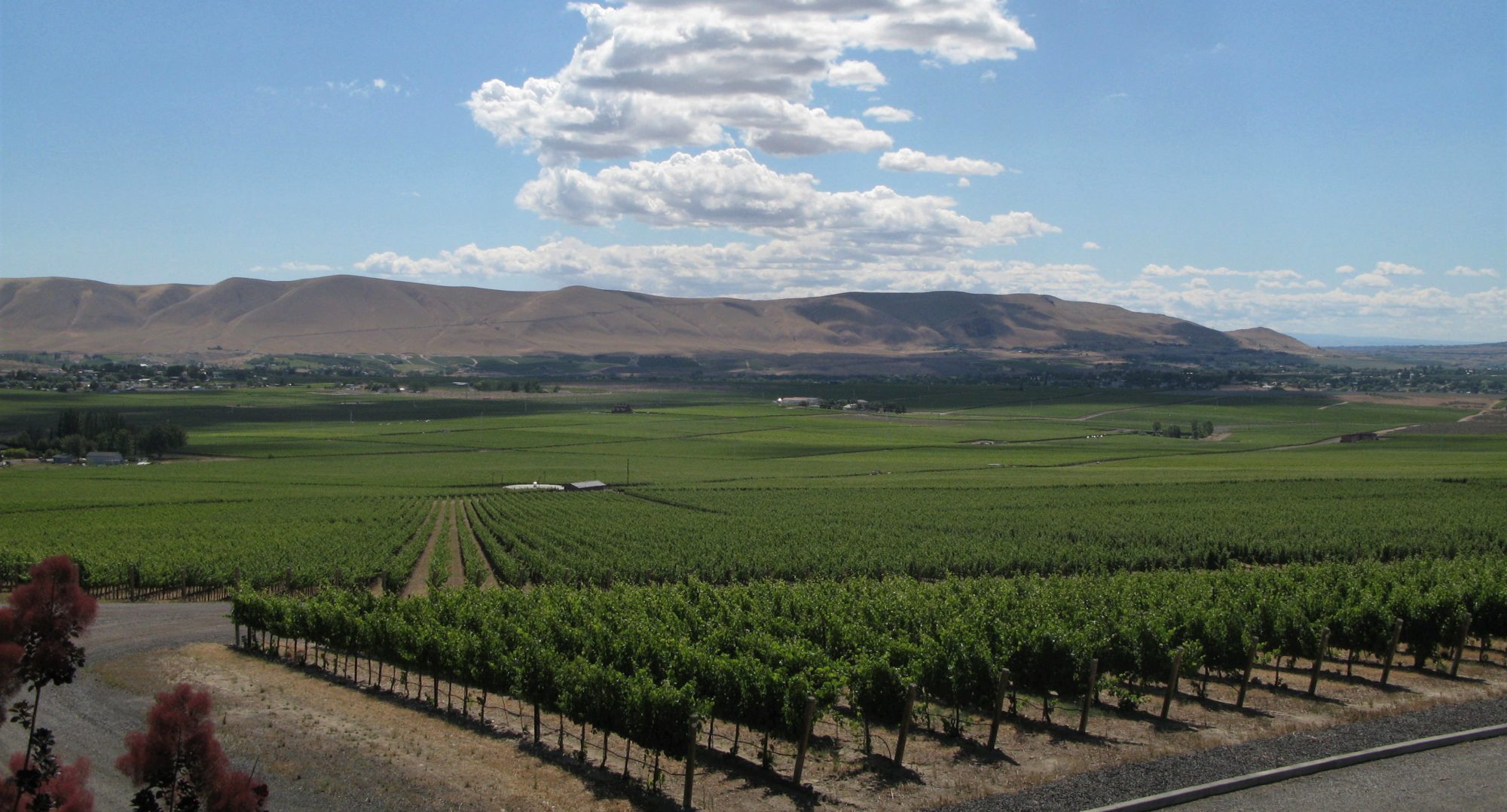
 Users Today : 1
Users Today : 1 Users Yesterday : 5
Users Yesterday : 5 Users Last 7 days : 49
Users Last 7 days : 49 Users Last 30 days : 271
Users Last 30 days : 271 Users This Month : 161
Users This Month : 161 Users This Year : 1541
Users This Year : 1541 Total Users : 16955
Total Users : 16955 Views Today : 1
Views Today : 1 Views Yesterday : 6
Views Yesterday : 6 Views Last 7 days : 59
Views Last 7 days : 59 Views Last 30 days : 346
Views Last 30 days : 346 Views This Month : 197
Views This Month : 197 Views This Year : 2167
Views This Year : 2167 Total views : 32531
Total views : 32531 Who's Online : 0
Who's Online : 0